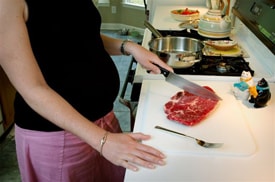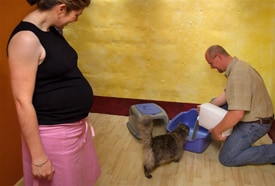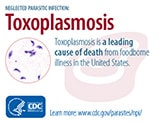Epidemiology & Risk Factors
Toxoplasmosis is caused by the protozoan parasite Toxoplasma gondii. In the United States it is estimated that 11% of the population 6 years and older have been infected with Toxoplasma. In various places throughout the world, it has been shown that more than 60% of some populations have been infected with Toxoplasma. Infection is often highest in areas of the world that have hot, humid climates and lower altitudes, because the oocysts survive better in these types of environments.
Toxoplasmosis is not passed from person-to-person, except in instances of mother-to-child (congenital) transmission and blood transfusion or organ transplantation. People typically become infected by three principal routes of transmission:

Always cook meat thoroughly and use clean knives, utensils and cutting boards on all foods. (Credit: CDC)
Foodborne transmission
The tissue form of the parasite (a microscopic cyst consisting of bradyzoites) can be transmitted to humans by food. People become infected by:
- Eating undercooked, contaminated meat (especially pork, lamb, and venison) or shellfish (like oysters, clams, and mussels);
- Accidentally ingesting undercooked, contaminated meat or shellfish after handling it and not washing hands thoroughly (Toxoplasma cannot be absorbed through intact skin); and
- Eating food that was contaminated by knives, utensils, cutting boards or other foods that had contact with raw, contaminated meat or shellfish.
- Drinking unpasteurized goat’s milk (tachyzoites).
Animal-to-human (zoonotic) transmission
Cats play an important role in the spread of toxoplasmosis. They become infected by eating infected rodents, birds, or other small animals. The parasite is then passed in the cat’s feces in an oocyst form, which is microscopic.
Kittens and cats can shed millions of oocysts in their feces for as long as 3 weeks after infection. Mature cats are less likely to shed Toxoplasma if they have been previously infected. A Toxoplasma-infected cat that is shedding the parasite in its feces contaminates the litter box. If the cat is allowed outside, it can contaminate the soil or water in the environment as well.

Have someone else clean the litter box. (Credit: CDC)
People can be infected by:
- Accidental ingestion of oocysts after cleaning a cat’s litter box when the cat has shed Toxoplasma in its feces
- Accidental ingestion of oocysts after touching or ingesting anything that has come into contact with a cat’s feces that contain Toxoplasma
- Accidental ingestion of oocysts in contaminated soil (e.g., not washing hands after gardening or eating unwashed fruits or vegetables from a garden)
- Drinking water contaminated with the Toxoplasma parasite
Mother-to-child (congenital) transmission
A woman who is newly infected with Toxoplasma during or just before pregnancy can pass the infection to her unborn child (congenital infection). The woman may not have symptoms, but there can be severe consequences for the unborn child, such as diseases of the nervous system and eyes.
Rare instances of transmission
Organ transplant recipients can become infected by receiving an organ from a Toxoplasma-positive donor. Rarely, people can also become infected by receiving infected blood via transfusion. Laboratory workers who handle infected blood can also acquire infection through accidental inoculation.
